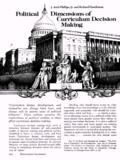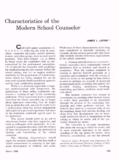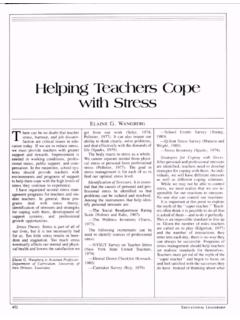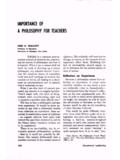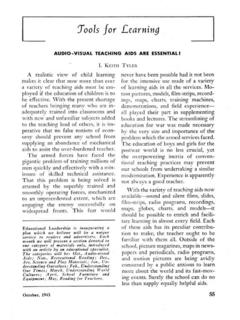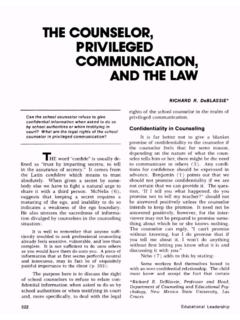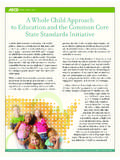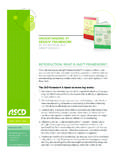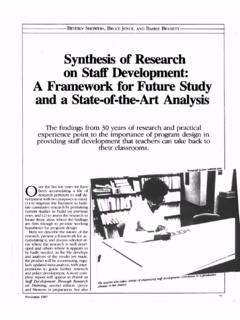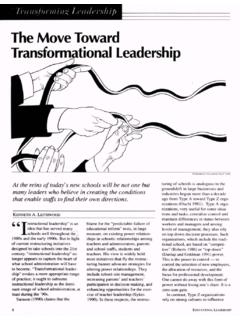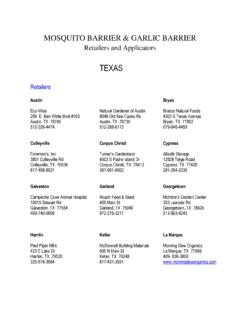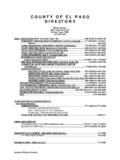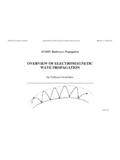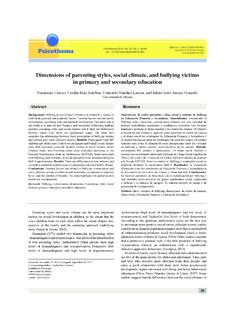Transcription of Teacher Behavior - ASCD
1 Teacher BehaviorandStudent LearningJere E. Brophyo ~ = = ~ = = = = ~ = ~ =~ = = ~ ~ =~ = ~ ~ = = = ~ K=q = = = ~ = K= = = ~ =~ = = ~ =~ =~ = =~ = = ~ = = = ~ KIn recent years, several large scale field correla tional studies have been conducted at various elemen tary grade levels (Stallings and Kaskowitz, 1974; Soar and Soar, 1972; McDonald and Elias, 1976; Tikunoff, Berliner, and Rist, 1975; Brophy and Evertson, 1976; Good and Grouws, 1977). These studies varied in the types of teachers and students included and the kinds of variables addressed and methods used, but there was sufficient overlap and replication to provide de pendable knowledge about relationships between Teacher Behavior and student learning of basic skills in the elementary grades (see reviews by Rosenshine, 1976; Medley, 1977; Borich and Fenton, 1977; and Good, 1979).
2 The data from these studies support what Rosenshine (1979) calls "direct instruction" as effective for producing student learning of basic skills? Critical aspects include: (1) teachers focus on academic goals; (2) promote extensive content coverage and high levels of student involvement; (3) select instructional goals and materials and actively monitor student progress; (4) structure learning activities and include immediate, academically oriented feedback; (5) create an environment that is task oriented but relaxed. Taken together, these studies provide strong support for the following generalizations:1. Teachers make a difference. Certain teacherselicit much more student learning than others, and their success is tied to consistent differences in teach ing Behavior (Good, Biddle, and Brophy, 1975; and Rakow, Airasian, and Madaus, 1978).2. Even so, there is no support for the notion of generic teaching skills, if these are defined as the types of very specific behaviors typically included in performance based Teacher education programs.
3 Few, if any, specific teaching behaviors are appropriate in all contexts. On the other hand, when data are integrated at a higher level of generality, several clusters or patterns are consistently related to learn ing One of these includes Teacher expectations and role definitions. Teachers who believe that in structing students in the curriculum is basic to their role, who fully expect to conduct such instruction,* The work reported herein is sponsored by the Institute for Research on Teaching, College of Education, Michigan State University. The Institute for Research on Teaching is funded primarily by the Teaching Division of the National Institute of Education, Department of Health, Education, and Welfare. The opinions expressed do not necessarily reflect the position, policy, or endorsement of the National Institute of Education. (Contract No. 400-76-0073).
4 This is an abridged version of an article entitled "Ad vances in Teacher Effectiveness Research." J ~ = =`lass- Room I ~ K=eouston: University of Houston, in 197933and who set about to do so in their classrooms, are more successful than teachers who do not. More ef fective teachers allocate more of their time for teach ing, and spend more of that time Another basic cluster includes such variables as classroom management skills, student engagement/ time on task, and student opportunity to learn ma terial. Effective teachers know how to organize and maintain a classroom learning environment that max imizes the time spent engaged in productive activities and minimizes the time lost during transitions, periods of confusion, or disruptions that require disciplinary Another cluster indicates support for the various elements of direct instruction. First, studies of general approaches to instruction consistently re veal that students taught with a structured curriculum do better than those taught with individualized or discovery learning approaches, and those who receive more instruction directly from the Teacher do better than those expected to learn on their own or from one another.
5 Teacher talk in the form of lectures and demonstrations is important, as are the time-honored methods of recitation, drill, and practice. It appears that most forms of open education or individualized instruction involve unrealistic expectations about the degree to which students in the early grades can manage their activities and learn independently (See the studies referenced earlier, and also Gage, 1978; Inman, 1977; and Stallings and Hentzell, 1978).The instruction that seems most efficient involves the Teacher working with the whole class (or with small groups in the early grades), presenting informa tion in lectures/demonstrations and then following up with recitations or practice exercises in which the students get opportunities to make responses and get corrective feedback. The Teacher maintains an aca demic focus, keeping the students involved in a lesson or engaged in seatwork, monitoring their perform ance, and providing individualized feedback.
6 The pace is rapid in the sense that the class moves efficiently through the curriculum as a whole (and through the successive objectives of any given lesson), but prog ress from one objective to the next involves very small, easy steps. Success rates in answering Teacher questions during lessons are high (about 75 percent), and success rates on assignments designed to be done independently are very high (approaching 100 per cent).6. These specifics vary somewhat with context, particularly grade level and student ability level. Within any given grade level, teachers working with low ability students need to move at a slower pace and provide more repetition and individualized mon itoring to make sure that overlearning is attainedbefore moving on to objectives that assume prior mastery of present objectives, and to supply greater warmth, encouragement, and personalized teaching generally, but less challenge (although not less than the students can handle) and fewer demands or criti cism (Brophy and Everston, 1976).
7 Current ProgressCurrent activities in the field feature two major trends: (a) integrating existing correlational findings and probing the limits of their generalization to con texts beyond basic skills instruction in the elementary grades; (b) experimental studies in which clusters of correlational findings are brought together into treat ment packages and assessed for degree of implementa tion by teachers and for success in producing more learning than what is observed in control InstructionGood (1979) notes that whole class, direct in struction is often maligned by those who favor in dividualized and self-paced instruction, but like recita tion, it survives. Good suggests, and I concur, that it survives because it has important advantages. It is easier to plan and manage, provides more modeling of correct thinking and responses for slower students, and avoids the elitism and labeling problems that can crop up when ability grouping is notes that direct instruction seems clearly superior to open education for producing mastery of basic skills.
8 It may not be the best approach for curricular areas that do not involve skill mastery, but instead seeks to promote appreciation, general famili arity, enrichment, or student personal development. (Open education is not necessarily effective here, either. In this connection, Good notes that open edu cation advocates have put too much stress on things like free choice of tasks or free movement around the room, which are less vital to real-life application than things like developing skills for problem solving and self-evaluation.) In any case, some structure is needed for most educational activities, and relatively more is needed in the early grades, for low ability students, and for anxious or dependent ManagementRecent publications by Brophy and Putnam (1979) and Evertson and Anderson (1978) have elaborated knowledge about what constitutes effective classroom management and about how it interacts with effective instruction.
9 Brophy and Putnam review studies on classroom management generally, not just those that link it with student learning. They note strong support for most of the variables stressed by34 EDUCATIONAL LEADERSHIPK ounin (1970): "withitness," overlapping, signal con tinuity and momentum during lessons, and variety and challenge during seatwork. They note that recent studies have not supported Kounin's variables of group alerting and accountability, which call for the teachers to be random and unpredictable in their ques tioning, to call on nonvolunteers frequently, and to require students to comment on one another's re sponses (to make sure that they pay attention to peers as well as to the teachers). These group alerting and accountability techniques either correlate negatively or show curvilinear relationships with learning gains. Apparently, teachers who do all the other things that Kounin stresses, and therefore are successful in max imizing student attention and engagement, should not need to use group alerting and accountability be haviors very and Anderson (1978) have been ex ploring the specifics involved in organizing and man aging the classroom, and the interactions between management and instruction.
10 They observed heavily during the first three weeks of school, and periodically thereafter, in 28 third-grade classrooms, gathering information on what rules and procedures the teach ers introduced, and how they did so. The next year they observed in junior high school classrooms. Pre liminary results from the study strongly support two major generalizations: (a) classroom organization and management skills are intimately related to instruction skills; good instructors tend to be good managers; (b) at least at the third-grade level, good organization and management is good instruction. That is, success ful classroom managers spend a great deal of time early in the year conducting semi-formal lessons to familiarize students with rules and procedures. This research is yielding rich, detailed information about procedures involved in setting up effective classrooms (Evertson and Anderson, in press).
